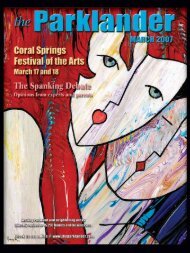celebratingour 2 0 thyear - The Parklander Magazine
celebratingour 2 0 thyear - The Parklander Magazine
celebratingour 2 0 thyear - The Parklander Magazine
- No tags were found...
You also want an ePaper? Increase the reach of your titles
YUMPU automatically turns print PDFs into web optimized ePapers that Google loves.
FROM THE EXPERTSDo you know someone that stutters?By Robin Best, M.A., C.C.C., P.A.Part of my practicum graduate training as a speech language pathologistwas to go to three separate places and stutter on purpose to see how otherpeople responded and how it made me feel. Well, of all the assignmentsI’ve ever had in my school career this was a lesson learned andremembered for more than 25 years. <strong>The</strong> general public can be impatient,condescending, perplexed and even mean when it comes to dealing with aperson who stutters. I encountered these attitudes and it caused me to feelinadequate, self-conscious, and out of place.Whenever I work with a client/patient I try to remember how I felt whenI posed as someone with a speech impediment. I remind myself that this istheir everyday life. Communication is one of the most essential parts ofour existence as human beings other than the bodily functions that keep usalive and productive.People who stutter are predominately male at a ratio of 5 to 1. <strong>The</strong>y areusually high achievers, perfectionists, with average to above-averageintelligence. Rather than continuing to profile these people into a specificset of criteria, suffice it to say … they are in good company with otherpeople that stutter such as: Winston Churchill, Bruce Willis, Carly Simon,James Earl Jones, John Stossel and Tiger Woods. I believe that the statisticthat one of every 100 people has some level of dysfluency is accurate.If stuttering is so prevalent why don’t we know more about it? Goodquestion. My response to that is we need to make the effort to learn moreabout those who stutter, why people stutter and what the listener can do sowe can be helpful to a very important segment of our population that isoften misunderstood and often harassed, teased and taunted.First and foremost we need to define stuttering. In the book Terminology ofCommunication Disorders, Speech Language Hearing, authors LucilleNicolosi, Elizabeth Harryman and Janet Kresheck define stuttering as,“Disturbance in the normal fluency and time patterning of speechcharacterized by one or more of the following: (a) audible or silent blocking;(b) sound and syllable repetitions; (c) sound prolongations; (d) interjections;(e) broken words; (f) circumlocutions; or (g) words produced with an excessof tension.” <strong>The</strong>se are the primary characteristics of stuttering. Secondarycharacteristics often accompany the primary symptoms such as: loss of eyecontact, body position and posture, hand banging, kicking or tapping,avoidance behavior–just to name a few.Stuttering usually begins between ages of 2 and 6. <strong>The</strong>se same ages arealso indicative of a normal developmental dysfluency that a youngster willgrow out of naturally. It is important to differentiate the two and maybe advisable to seek professional help to discern the difference. It is notpossible to explain all the characteristics of stuttering in an article such asthis. But I’m sure that if you have any concerns at all for yourself or yourloved ones you should learn more on your own.When speaking to a person that stutters try to follow these guidelines.• Let them finish what they are saying with patience.• Model a slower easier pattern of speech to help pace them.• Do not tell them to stop or relax or slow down while they are speaking.• Maintain eye contact with them.• Do not finish their thought.In conclusion, if you or someone you know stutters, educate yourself withresources such as the Stuttering Foundation of America, and books andarticles found at the library and universities. Call a professional forhelp. Recovery for fluency therapy can be as high as 80 percent. Earlyintervention is the key to avoiding negative social interaction andencouraging better self-esteem.86 MAY 2010Robin Best, M.A., C.C.C., P.A., is a speech language pathologist.
















